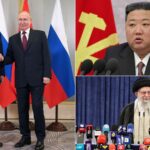Nuclear-armed North Korea fired off two medium-range ballistic missiles on Sunday, just days after Tokyo committed to acquiring a so-called counterstrike capability that would allow it to strike enemy bases and command sites — including inside North Korea.
Both missiles were launched from an area near North Korea’s western coast and flew about 500 kilometers, hitting maximum altitudes of around 550 km, before landing in the Sea of Japan in waters outside Japan’s exclusive economic zone, which extends 200 nautical miles (370 km) from its coast, State Minister for Defense Toshiro Ino told reporters.
“Since the beginning of this year, North Korea has repeatedly launched missiles at an unprecedented frequency, significantly increasing tensions on the Korean Peninsula and in the region,” Ino said. “This series of escalating provocations by North Korea threatens the peace and stability of our region and the international community and cannot be tolerated.”
The South Korean military also confirmed the launches, saying they were of medium-range weapons that had been launched at steep angles.
The latest launches come amid a record-breaking year of missile tests by the isolated country, stoking concern in Tokyo.
Prime Minister Fumio Kishida’s government on Friday approved what he called “a major shift” in the country’s defense and security policies, with his Cabinet passing revisions to three key security documents that lay the foundation for Japan’s diplomatic and defense policies for years to come.
In it’s new National Security Strategy, one of the three documents that was revised, Japan took aim at the the “unprecedented frequency” and “new ways” that North Korea has conducted missile launches in recent years, warning over the “rapid progress in its missile-related technologies and operational capabilities.”
“North Korea intends to bolster its nuclear capabilities both in quality and in quantity at the maximum speed. When considered together with its rapid development of missile-related technologies, North Korea’s military activities pose an even more grave and imminent threat to Japan’s national security than ever before,” the strategy added.
As part of the policy shift, Japan also formally committed in the documents to acquiring the counterstrike capability, which would employ longer-range standoff missiles and give Tokyo a powerful deterrent in the face of the North Korean missile threat.
This is especially important, analysts say, as the North continues to make advances in technologies that allow its missiles to evade defenses, including those that fly on irregular trajectories or are capable of being launched from various platforms such as transporter erector-launchers, submarines and trains.
The North has also appeared to make progress with its solid-fueled missiles that are more easily transportable and eliminate the need for fueling at launch sites, which potentially leaves the weapons and their crews vulnerable to early strikes.
In the latest example of this progress, North Korean leader Kim Jong Un on Thursday oversaw the test of a powerful new engine believed to be intended for a new solid-fuel intercontinental ballistic missile, given its claimed thrust.
The North called the test “the first of its kind” in the country.
Kim laid out the target of developing a solid-fuel ICBM as part of a laundry list of five key goals for bolstering his country’s nuclear weapons program at a ruling party meeting last year.
After overseeing last week’s test, Kim said “another important problem in carrying out the five priority tasks” was successfully completed, and expressed “expectation that another new-type strategic weapon would be made in the shortest span of time,” the state-run Korean Central News Agency reported.















